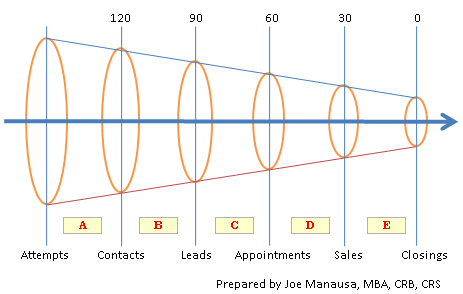Real Estate Prospecting – Back To The Basics
June 18, 2008
Contrary to the gloom and doom being spread throughout the real estate industry, real estate sales is rather predictable. This is true in every market cycle, the key is to know what to look for and what to measure.
There are actions that we must take that will create known reactions. Too often, I hear agents talk about market conditions as if the market has the ability to shut down one’s production. Now, I suspect if we went into the great depression, something like that would be possible. But the fact is that a single agent does not have to be affected by market conditions if the agent understands where the business really comes from. It is time to go back to the basics.
Anything Worth Doing is Worth Measuring
I have measured real estate prospecting and lead source results for years. Early in my career, I was taught that “anything worth doing is worth measuring.” So I figured I would share the results of some of this measurement. Often times, the content in the Tallahassee Real Estate Blog contains charts and graphs that were created through daily measurement.
Real Estate Prospecting Glossary
In order to share these results, we must establish some common language. The study of real estate prospecting requires that we all use some common terms so that we are talking about the same thing. The following glossary will explain some key words that these measurements are built around.These are the key elements of the sales cycle:
Attempts – This is the process of trying to communicate with somebody. Dialing the phone, knocking on a door are two great examples of an attempt.
Contacts – A contact is measured when we have a real estate, fact-finding conversation with another person. Talking to somebody at the grocery store about your child’s baseball game is not a contact. Seeing somebody in public and eventually asking them “who do you know that is looking to buy or sell real estate” would be measured as a contact.
Leads – A lead is identified as anybody looking to buy or sell real estate within a certain amount of time. If I were a new agent, I would use a one-year time frame, if I were already established and had good systems, I might adjust this down to 6 months or less.
Appointments Set – Appointments set are measured every time we set an appointment with a new customer. The key is to only measure the “1st” appointment with a customer, whereas follow-up appointments with the same customer are not factored into this measurement.
Appointments Conducted – We measure the first meeting with every new lead in order to determine how effective our real estate prospecting has been as well as how well we convert our appointments.
Sales – A sale is “new ink.” A new pended side is the result of all of our real estate prospecting. The key is to measure when you succeed in a yes decision by the customer.
Closings – Every time you close on a real estate “side,” you measure this.
So now that we have the common language established, let’s take a look at the real estate business funnel and how real estate prospecting feeds the entire cycle. The follow graphic shows the relationship of each of these different points:
The Real Estate Business Funnel
There is a lot to be gleaned from the business funnel. First of all, look across the top of the graphic and you will see that it shows a time-line. Working from right to left, we can see that for a closing to occur, we must write a contract (sale) roughly 30 days earlier. For a sale to occur, we must have a first appointment roughly 30 days prior to that. For this appointment, we must follow-up on leads prior, etc., etc., etc. The funnel shows us that attempts bring contacts, contacts generate leads, leads bring appointments, appointments bring sales, and sales lead to closings. That is the real estate funnel!
Measuring Key Actions
If we look at the bottom of the graphic, we see that several key measurements have been labeled “A” through “E”. If a real estate agent who is active in real estate prospecting will measure the key actions described above, the agent will then begin to record results and study these key ratios. How many contacts do you make to get a closing? How many appointments to get a sale? These measurements can really help quantify the real results that an agent achieves and will help this agents’ coach make modifications to the work schedule, resulting in higher earnings for the agent (or fewer hours worked).
Note that from left to right, the real estate funnel is much like a funnel you would use in the kitchen. The left side of the funnel is much larger than the right side, implying that we must make many more attempts and contacts than we are going to get as sales. This is a graphical explanation to the old adage that “sales is a numbers game.”
Putting It Into Practice
I hope every serious real estate professional can learn to measure the results of real estate prospecting. I have seen from personal experience good agents become great ones, once they identify their strengths and weaknesses through this process.
Comments
Got something to say?



